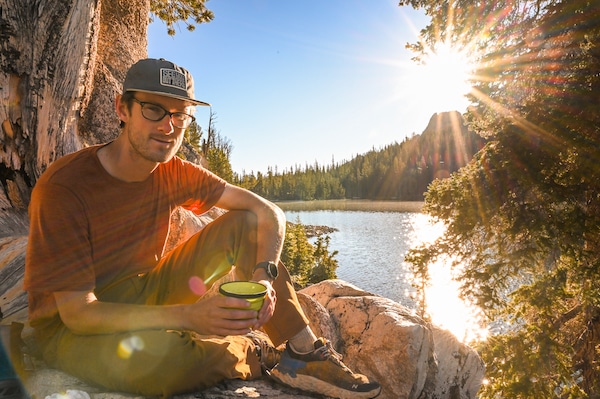
A love for outdoor recreation and an opportunity to work remotely led Matt Cafarella and his girlfriend Sarah Vaughn to move to Idaho Falls and enjoy a more relaxed, yet equally rewarding, life in Idaho. Photo by Two Outliers
By Teresa Bergen
Sarah Vaughan and Matt Cafarella never intended to move to Idaho. But in March of 2021, the Richmond, Virginia couple was sick of being Covid quarantined. They decided to sell most of their stuff, hit the road and work their full-time jobs remotely from wherever. They packed their car and along with their cat Fitzgerald set off to explore different parts of the country.
One of those places was Idaho Falls, a city of 61,000 and Eastern Idaho’s cultural hub on the Snake River. “Pre-pandemic, we would never have been able to be there, working for any extended period of time,” said Cafarella. He and Vaughan rented a place for a month and a half, using it as a base to explore Idaho and the Teton Mountains just across the border in Wyoming. “We never really wanted to leave.”
Their story is increasingly common. Young people living in a cramped urban apartment discover they can earn just as much money working remotely from a location that offers larger homes for less money. But those who come to Idaho largely are attracted by the outdoor space. “Virginia has backpacking, hiking and kayaking,” admits Cafarella. “But not like it is in Idaho. Here it’s a whole different level.”
And they’ve found a new favorite pursuit: rock climbing. “Which isn’t really a thing in Richmond, Virginia.”
They were floored by the variety of landscapes, from big, jagged mountains like the Sawtooths in the center of the state, to the grasslands of southeastern Idaho, to the bizarre lava, cinder cones and sagebrush of Craters of the Moon National Monument and Preserve in central Idaho. “There’s sort of a little bit of everything here,” Vaughan says.
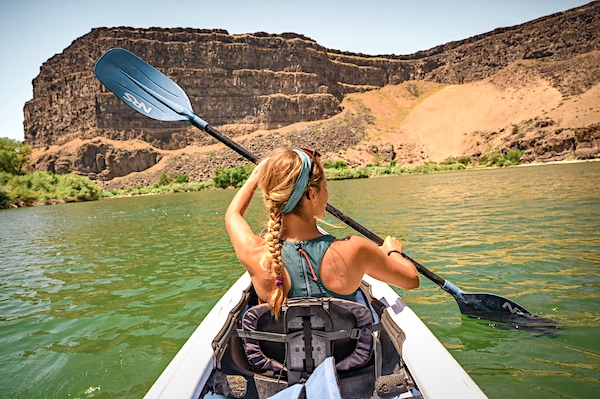
Sarah Vaughan enjoys kayaking near Shoshone Falls. Towering more than 200-ft. above the Snake River, Shoshone Falls is higher than Niagara Falls. Photo by Two Outliers
The couple wound up buying land near Driggs, a small eastern Idaho town sitting at an elevation of over 6,000 feet. From their land, they can see rolling farmland, smaller mountains, and the Tetons in neighboring Wyoming.
The move surprised their friends and family. From an east coast perspective, Idaho conjured images of farmland and potatoes. While Idaho still leads U.S. potato production the state is now also known for its technology sector. Says Cafarella: “When we told people we were going to be there for a month and a half, they’re like, ‘What are you going to do in Idaho for a month and a half?’”
Now that their friends have heard of their adventures kayaking, backpacking, rock climbing and hiking, they’re excited to visit and see Idaho for themselves.
Avoiding Covid While Benefitting from It
Moving to Idaho isn’t a new idea. According to U.S. News and World Report, 2021 was the fifth year in a row that Idaho led national population growth. From 2020 to 2021, 53,000 new residents moved into the state, for a total population of about 1.9 million. Neighboring Montana and Utah are also growing quickly.
Boise has made several recent “best” lists, including number three for both Best US Metros for Digital Nomads and Best City for Remote Workers. The websites listed proximity to outdoor activities, restaurants, natural amenities and neighborly friendliness as driving factors.
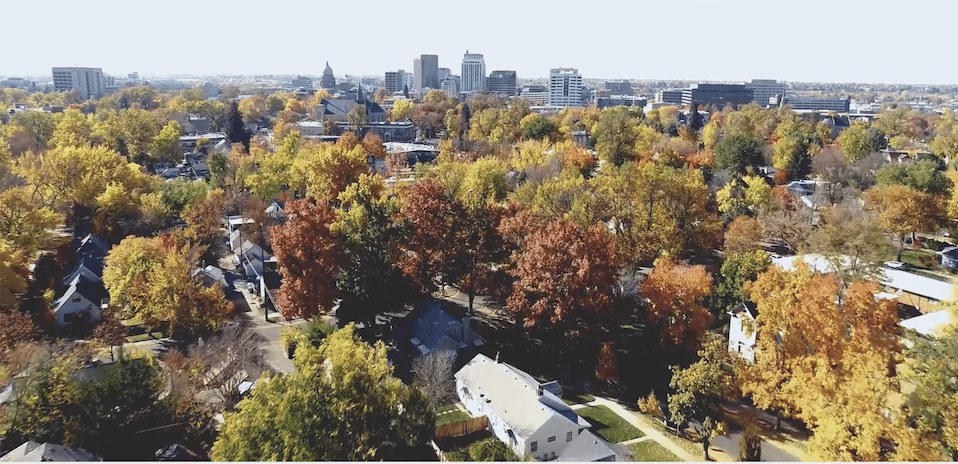
Idaho’s capital of Boise is one of the most livable cities in the U.S.
Of course, this means prices are going up, too. According to Zillow, the average Idaho home price in December 2021 was $451,830, up a whopping 33.4% from a year earlier. Not a problem for people from Silicon Valley or other wealthier areas moving in. But not always welcomed by native Idahoans suddenly priced out of buying a bigger home.
Fortunately, the growing population is mirrored by increased business startups and commercial revenues. Service industries are booming because of consumer demand. Communal workspaces also have profited from the influx of residents. From Boise to Ketchum, coworking spaces are offering remote workers and short-term vacationers community, desk space, and access to 3D printers.
A Fertile State for Putting Down Roots
Nobody’s going to confuse Boise with New York City, but it is possible to live in Idaho and enjoy big city amenities. The Morrison Center’s Broadway in Boise Season brings national touring shows to Idaho’s premier performing arts space every year. You can also catch classical and jazz concerts there. Boise, just 40 miles east of the Oregon border in southern Idaho, has a symphony, an opera, and even a thriving Basque community. But it’s also the City of Trees, a nickname attesting to Idahoans’ connection to the outdoors, even in the state’s biggest city.
In northwestern Idaho, Coeur d’Alene is on the north shore of the 25-mile long lake that shares the same name. About 55,000 live in Coeur d’Alene, many of them boaters. But residents also swap their deck shoes for dress shoes to attend live theater shows and art openings in downtown galleries.
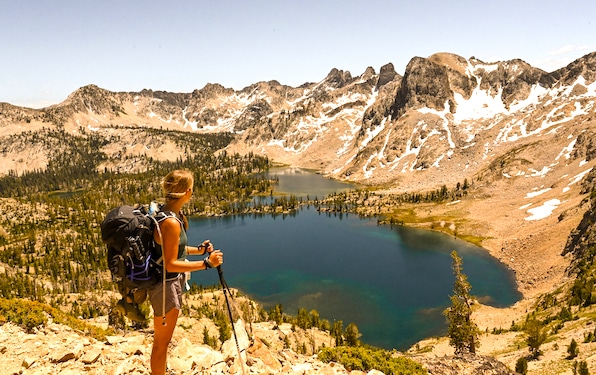
Sarah Vaughan pauses to take in the view while hiking the Alice Toxaway Trail in Idaho’s Sawtooth Wilderness. Photo by Two Outliers
Many people who move to Idaho from larger cities are drawn to the clean streets and fresh air of small towns. Hailey, in central Idaho’s Wood River Valley, has about 9,000 residents and is known for good schools, high community involvement and low pollution. It’s also the hometown of poet Ezra Pound. Just fourteen miles north of Hailey, the ski resort town of Sun Valley draws skiers and snowboarders in winter, mountain bikers in summer and celebrities year-round. Sun Valley is one of the most expensive places in Idaho to stay. It’s home to the Sun Valley Film Festival, symphony concerts and more than a dozen art galleries.
The allure of the wild
Tourists and residents both value Idaho for its outdoor opportunities. Nine out of TripAdvisor’s top ten Idaho tourism attractions are outdoor activities.
During the month and a half Vaughan and Cafarella spent in Idaho Falls, they took every weekend opportunity to get to know their adopted state, which they chronicled in their adventure travel blog, Two Outliers. In Central Idaho, they backpacked the Sawtooth Mountains, spiky remnants of an ancient shield volcano. They slept by Alpine lakes framed by jagged, snowy peaks.
Hot Time in the Cold Town
Stanley, one of Idaho’s quietest and most beautiful tiny towns, is in the Sawtooth Valley. It gets a little busy in summer, when people come to hike, mountain bike and raft the Salmon River. But in winter, the town settles down to its year-round population of 116—plus dozens of elk that come down from the mountains to winter in the valley.
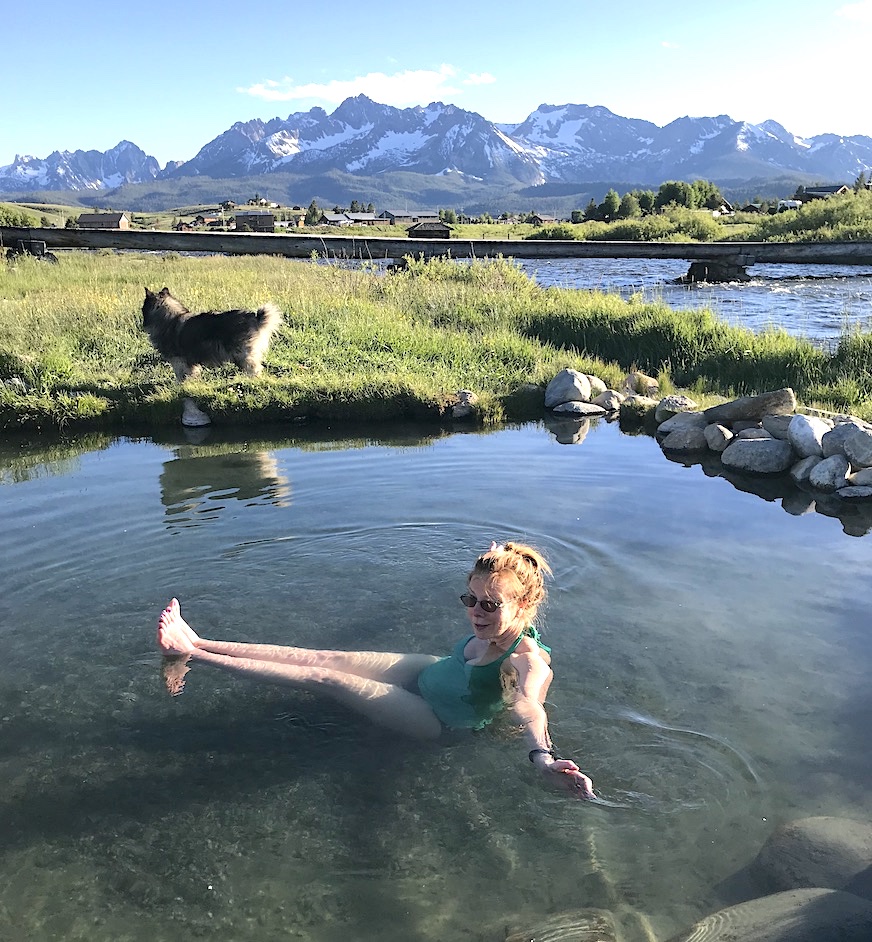
It can be cold in Stanley, but the thermal pools around the town always stay warm. Photo by Gideon Parque
Perhaps the human population thins because Stanley holds the title for coldest place in the continental US. It set a record cold temperature of -54 degrees in 1983, and also holds the record for the highest number of coldest days from 1995 to 2005.
But if you’re feeling very brave, venture out to Sunbeam Hot Springs on a dark and freezing winter night. Scamper down a short, snowy trail from highway 75, then strip as fast as you can and slip into a steaming natural pool. Just be sure to take a second to check the temperature—some pools are scalding. Once your heart rate settles down from multiple temperature shocks, you’ll have the incredible experience of being in an Idaho hot spring under the stars, with just some rocks separating you from the wild Salmon River.
Splashing through Idaho
Some of Idaho’s most popular recreation takes place on lakes. On the skinny northern panhandle, the heart of Idaho’s lumber industry, are two of the state’s biggest, Lake Pend Oreille and Coeur d’Alene. Sandpoint, Idaho is an excellent base for visitors who want a multisport vacation, with boating, biking, and hiking at the nearby 600-million-year-old Selkirk Mountain range, which stretches up into British Columbia. The town of 8,400 has a walkable downtown full of old brick buildings and easy lake access at City Beach. Cedar Street Bridge Public Market, packed with boutiques and restaurants, spans Sand Creek and is the only marketplace on a bridge in the US. Sandpoint has surprisingly good restaurants. Beet and Basil at the Creek creatively fuses American, Indian and South American cuisines and has lovely outdoor seating overlooking the water.
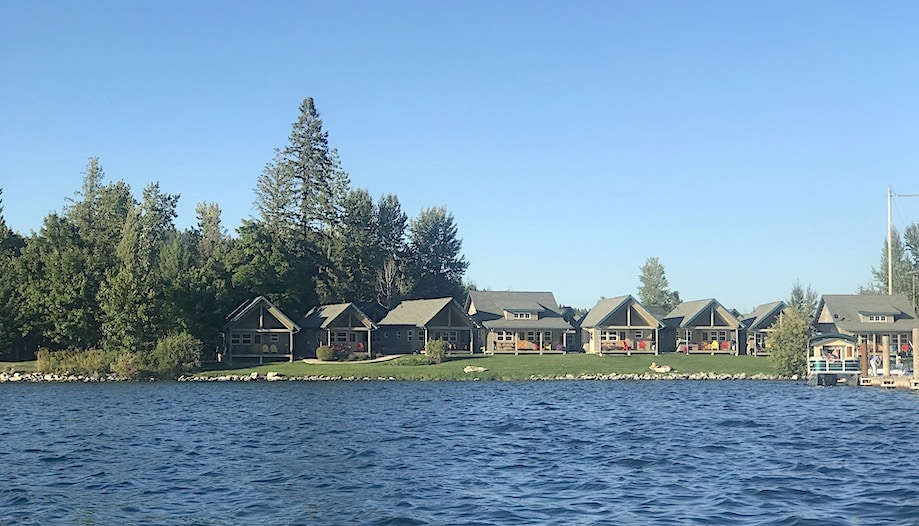
Dover Bay on Lake Pend Oreille attracts families from around the world looking for a relaxed, aquatic getaway. Everything from bicycles to power boats can be rented, along with other recreational gear.
For a lake-centered experience, rent a cottage at Dover Bay, a planned residential resort community four miles southwest of Sandpoint and connected by a bike path. The 285-acre development is all lake, all the time. Bring your boat. If you don’t have one, you can rent a kayak or standup paddleboard to explore Lake Pend Oreille, walk or bike on nine miles of trails along the water, look for wading birds. Birdwatchers have spotted more than 200 birds in Bonner County, from pectoral sandpipers to snow geese, depending on the season. You can swim in the lake or relax in the resort’s hot tub or swimming pool.
Don’t Forget the Zoom Lens
For a more elevating experience why not stalk some elusive big horned sheep. Hells Canyon, which straddles the Oregon/Idaho border, is one of the wildest places west of the Rocky Mountains. Explore it by raft for the ultimate adventure. Or, for thrills but with less chance of ending up in the drink, experience the whitewater of Hells Canyon on a jet boat tour. Huge columnar basalt cliffs jut out of the wild river. Keen-eyed river guides point out Rocky Mountain bighorn sheep, mule deer, wild turkeys and bald eagles.
Short Lift Lines and Uncrowded Skiing
In the summer of 2020, Schweitzer Mountain was a giant construction site as workers erected more Alpine condos. The ski resort eleven miles northwest of Sandpoint was revving up for an influx of winter population at Idaho’s largest, and hardest to reach, ski terrain.
The 2,900-acre area is two hours from Spokane, the closest airport, and a windy ten-hour drive from Boise. But more and more people are discovering it, along with Idaho’s other leading ski areas, Tamarack near Boise and celebrity-studded Sun Valley. In the past, Idaho hasn’t been top of mind when people think of ski destinations. But vacationers and home buyers are coming for the short lift lines and unpretentiousness. Schweitzer offers skiers gorgeous views of Lake Pend Oreille.
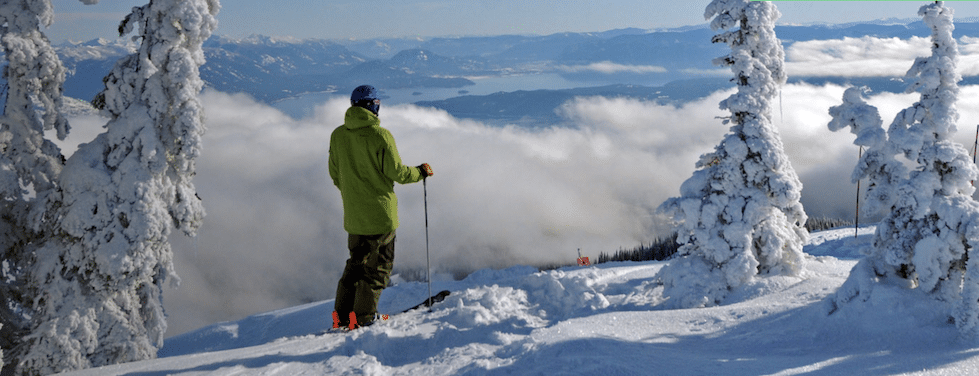
Idaho’s Schweitzer Mountain is not close to a major airport. But Alpine skiers willing to drive wil find well-groomed ski runs that start above the clouds.
The pandemic has fueled the demand for Idaho homes in general and ski homes in particular. M2 Construction, the company building condos at Schweitzer, has a three-year waiting list to begin new custom homes. Even after increasing prices from $550,000 to $950,000 per unit, their recent spec project sold out in a month. Lucky for tourists, many owners rent their units through Airbnb and other services when they’re not staying in them.
Idaho Festivals are Back!
Idaho has a solid post-pandemic 2022 festival lineup in place with wide-ranging activities. Western skijoring is a sport where horse and riders pull skiers through a challenging course with jumps and gates. But in February, Wallace, Idaho, in the state’s panhandle puts on a Wallace Extreme Ski Jor, where ATV riders pull skiers through an obstacle-laden course.
Music fans flock to Boise in late March for the annual Treefort Music Fest. In addition to more than 400 bands of different genres, the festival features a collection of “forts,” or special interest venues. Yogafort hosts a lineup of yoga classes, while Dragfort showcases drag performers. Gamers and other techies can congregate at Hackfort. And sooner or later, everybody needs Foodfort.
In the 1860s, Welsh pioneers settled in the Malad Valley near Idaho’s Utah border. Now the valley claims the largest per-capita concentration of folks of Welsh ancestry outside Wales. Celebrate their history at the Malad Valley Welsh Festival in late June.
The Trailing of the Sheep Festival near Ketchum and Hailey, close to Sun Valley, is perhaps the state’s most unusual annual event. Sheep ranchers traditionally trailed their sheep up into the mountains for summer grazing, then brought them south in the fall. In October, this festival features a massive sheep parade, sheepdog trials and sheep-themed storytelling.
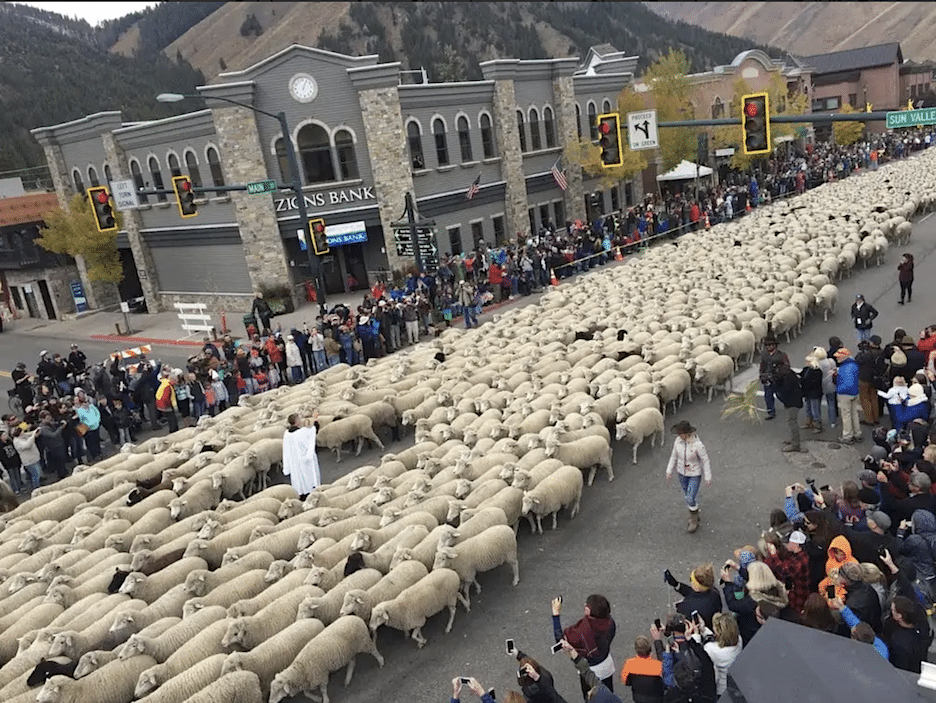
Every October the Trailing of the Sheep Festival takes place in Idaho. The Festival is five days of nonstop family events including multicultural performers, storytelling, culinary events and cooking classes, a Wool Festival, Championship Sheepdog Trials and the Big Sheep Parade with 1,500 sheep trailing down Main Street in Ketchum, Idaho. Photo by Terry Sanders
Idaho Attracts Tourists and New Residents
The state seems less remote as more remote workers move in. And the trend will likely continue. The two outliers Vaughan and Cafarella are a microcosm of how the pandemic has shaken up the American workspace, enabling alternate living possibilities. When their jobs eventually called them back into the Richmond office, they said no way. Cafarella was able to work out an arrangement to make his job permanently remote. Vaughan, a data scientist, simply switched jobs. “In data science, there are tons of remote opportunities,” said Vaughan. “So it was not too much of a problem.”
The same attractions that attract remote workers are drawing vacationing professionals and traveling families from around the world. As cities feel increasingly congested, visitors feel liberation in Idaho’s short lift lines, pristine lake views and fresh mountain air.![]()
Portland travel writer Teresa Bergen’s most recent story for EWNS was a must-read on cemetery tourism.

